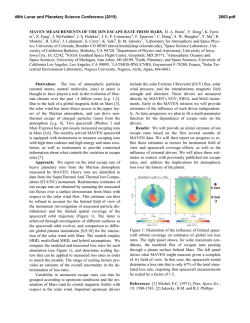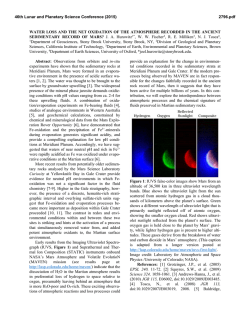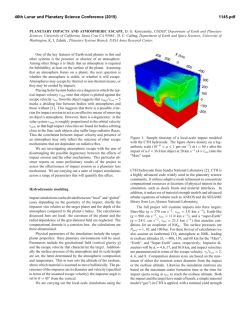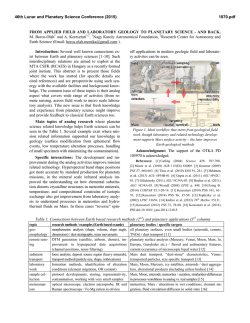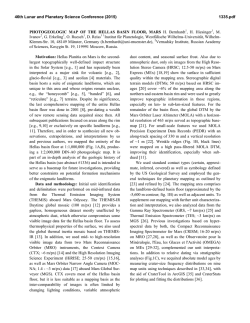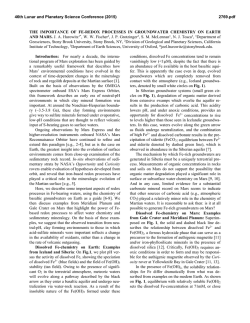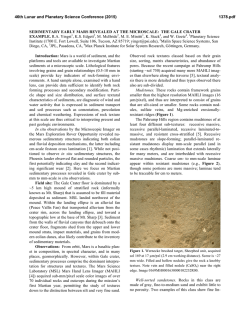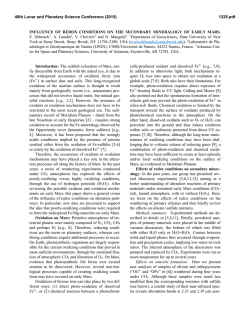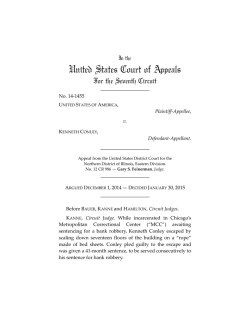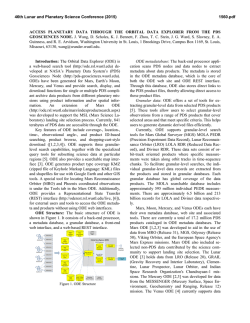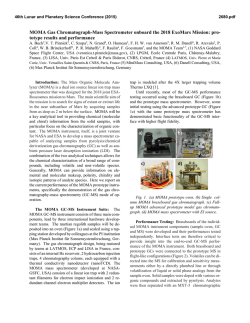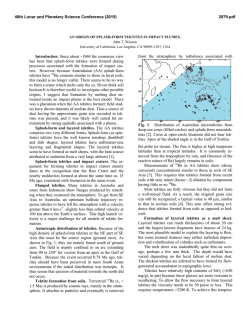
2389
46th Lunar and Planetary Science Conference (2015) 2389.pdf MAVEN DATA-MODEL COMPARISONS OF PLANETARY IONS S. M. Curry1 J. G. Luhmann1, C. F. Dong2, F. Leblanc3, R. Modolo3, Y. Ma4, J. Halekas5, J. McFadden1, D. Mitchell1, D. Larson1, J. Connerney6, J. Espley6, R. Lillis1, D. Brain7, X. Fang7, R. Livi1, T. Hara1, Y. Harada1, B. M. Jakosky7, 1Space Sciences Laboratory, Univ. of California at Berkeley, Berkeley, CA, 94720 ([email protected]), 2Atmospheric Oceanic and Space Sciences, University of Michigan, Ann Arbor, MI 48109 3LATMOS-IPSL/CNRS, Guyancourt F-78280, France, 4Earth, Planetary, and Space Sciences, University of California Los Angeles, Los Angeles, CA 90095, 5 Department of Physics and Astronomy, University of Iowa, Iowa City, IA 52242, 6NASA Goddard Space Flight Center, Greenbelt, MD 20771, 7Laboratory for Atmospheric and Space Physics, University of Colorado, Boulder CO 803033 Motivation: Diagenetic and isotopic evidence suggests that Mars hosted large inventories of water (e.g. [1,2]), that are now either sequestered in the regolith or, alternatively, have escaped to space [3]. When water in the atmosphere is photodissociated, the resulting hydrogen can be removed via thermal or hydrodynamic escape [4], while the resulting oxygen (16 times heavier) requires other processes to attain the ~5 km/s escape velocity. Dissociative recombination of the main ionospheric constituent, O2+, provides one photochemical pathway that is dominant today. However, over the several billion year history of Mars, other mechanisms are needed to explain the removal of the oxygen in sufficient quantities to account for the estimated early water inventory. Alternative non-thermal mechanisms for enabling oxygen escape arise from the interaction of the Martian atmosphere with the solar wind. Mars lacks a strong intrinsic dipole magnetic field, which creates a scenario where the neutral oxygen in the upper atmosphere can be ionized and 'picked up', or accelerated by the background convective electric field. Such pick-up ions enable two significant processes for additional oxygen escape: 1) sputtering via pick-up ion precipitation back into the atmosphere, as well as 2) direct ion escape [5]. In the first process, pick-up ions, having been accelerated to suprathermal energies, are moving on trajectories that intersect the atmosphere. Here, they deposit their energy to the surrounding atmospheric particles via collisions in a process known as sputtering. Collisions with neutral oxygen in particular, can result in sufficient momentum exchange, causing one or more neutral oxygen atoms to escape. In the second process, oxygen can escape when it is ionized and swept away by the solar wind on a trajectory that does not intersect the atmosphere. This second process, pick-up ion escape, is the focus of the data-model comparison presented here. Approach: Simultaneous measurements of plasma and magnetic fields are critical for assessing how much pick-up ions contribute to Mars’ atmospheric escape; Mars Atmospheric and Volatile EvolutioN (MAVEN) is the first spacecraft since Phobos orbited Mars in 1988 to carry both plasma instruments and a magne- tometer. Additionally, numerical advances in global, physics-based models have served as important an aid for interpreting the observations. In our studies, MAVEN observations are compared to model results from the Mars Test Particle (MTP) simulation and the BATS-R-US magnetohydrodynamic (MHD) simulation. These simulations use a realistic 3-D neutral atmosphere description as well as nominal solar wind conditions as inputs in order to capture the fluid and kinetic behavior of the upper atmosphere at Mars [6,7]. Using the available observations, we present comparisons of modeled planetary pick-up ions with MAVEN data to both validate the models and better constrain global atmospheric loss rates at Mars. Past data observations have indicated that most of the pickup ion escape is behind the planet through the solar wind plasma wake [8], but numerous simulations have predicted an additional high-energy ‘plume’ that contains a significant part of the escaping ion flux [9,10]. Using MAVEN observations, we demonstrate the existence of such a plume with, which is characterized by a high degree of asymmetry controlled by the interplanetary magnetic field (IMF) orientation. Results: Figure 1: The Molleweide projection of escaping O+ from 3 RM is looking directly downtail of the planet. The flux is on a log scale in units of cm-2 s-1. The top 46th Lunar and Planetary Science Conference (2015) panel illustrates the escape pattern for an away sector IMF while the bottom panel illustrates the escape pattern for a towards sector IMF. The high energy O+ plume occurs in either the Northern or Southern hemisphere for the away and towards sector IMF configurations, respectively, as seen in Figure 1. Using the suite of models mentioned above, we compare maps of this pick-up ion plume with what is observed by MAVEN, which currently has an orbit with apoapsis in the Southern Hemisphere. We identify where the IMF reverses from a towards to away sector in the magnetic field data using MAG and SWEA, and compare the high altitude observations of O+ using STATIC and SWIA. We identify pick-up ion escape through the wake as well as through the predicted, localized plume feature that moves around with the IMF orientation and is spatially distinct from the lower energy wake escape. The consistency of the escaping pick-up ion observations with the models supports the future uses of the models for both global and historical extrapolations of ion escape from Mars. References: [1] McElroy et al. (1982) Science 251, 1614 [2] Squyres et al., (2004) Science, 306(5702), 1709-14 [3] Jakosky et al. (2002) Nature 412, 237-244 [4] Kasting et al. (1983) Icarus 53(3), 479-508 [5] Luhmann et al. (1991), JGR, 96, 5457. [6] Bougher et al. (2009) GRL, 36 [7] Dong et al. (2014) GRL, 41 [8] Lundin et al. (2004) Science, 305, 5692 [9] Curry et al. (2014) JGR, 119, 2328-2344 [10] Fang et al. (2008) JGR, 113, A2 2389.pdf
© Copyright 2025
